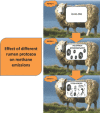Effect of progressive inoculation of fauna-free sheep with holotrich protozoa and total-fauna on rumen fermentation, microbial diversity and methane emissions
- PMID: 25764558
- PMCID: PMC4399445
- DOI: 10.1093/femsec/fiu026
Effect of progressive inoculation of fauna-free sheep with holotrich protozoa and total-fauna on rumen fermentation, microbial diversity and methane emissions
Abstract
Rumen methanogenesis represents an energy waste for the ruminant and an important source of greenhouse gas; thus, integrated studies are needed to fully understand this process. Eight fauna-free sheep were used to investigate the effect of successive inoculation with holotrich protozoa then with total fauna on rumen methanogenesis. Holotrichs inoculation neither altered rumen fermentation rate nor diet digestibility, but increased concentrations of acetate (+15%), butyrate (+57%), anaerobic fungi (+0.82 log), methanogens (+0.41 log) and methanogenesis (+54%). Further inoculation with total fauna increased rumen concentrations of protozoa (+1.0 log), bacteria (+0.29 log), anaerobic fungi (+0.78 log), VFA (+8%), ammonia and fibre digestibility (+17%) without affecting levels of methanogens or methanogenesis. Rumen methanogens population was fairly stable in terms of structure and diversity, while the bacterial community was highly affected by the treatments. Inoculation with holotrich protozoa increased bacterial diversity. Further inoculation with total fauna lowered bacterial diversity but increased concentrations of certain propionate and lactate-producing bacteria, suggesting that alternative H2 sinks could be relevant. This experiment suggests that holotrich protozoa have a greater impact on rumen methanogenesis than entodiniomorphids. Thus, further research is warranted to understand the effect of holotrich protozoa on methane formation and evaluate their elimination from the rumen as a potential methane mitigation strategy.
Keywords: entodiniomorphids; fermentation; holotrichs; methanogenesis; methanogens; rumen protozoa.
© Federation of European Microbiological Society 2014.
Figures


Similar articles
-
Study of methanogen communities associated with different rumen protozoal populations.FEMS Microbiol Ecol. 2014 Dec;90(3):663-77. doi: 10.1111/1574-6941.12423. Epub 2014 Sep 29. FEMS Microbiol Ecol. 2014. PMID: 25195951 Free PMC article.
-
Effects of protozoa on methane production in rumen and hindgut of calves around time of weaning.Arch Tierernahr. 2003 Aug;57(4):279-95. doi: 10.1080/00039420310001594423. Arch Tierernahr. 2003. PMID: 14533867
-
Rumen protozoa and methanogenesis: not a simple cause-effect relationship.Br J Nutr. 2012 Feb;107(3):388-97. doi: 10.1017/S0007114511002935. Epub 2011 Jul 18. Br J Nutr. 2012. PMID: 21762544
-
A new perspective on the use of plant secondary metabolites to inhibit methanogenesis in the rumen.Phytochemistry. 2010 Aug;71(11-12):1198-222. doi: 10.1016/j.phytochem.2010.05.010. Phytochemistry. 2010. PMID: 20570294 Review.
-
[Methanogens and manipulation of methane production in the rumen].Wei Sheng Wu Xue Bao. 2005 Feb;45(1):145-8. Wei Sheng Wu Xue Bao. 2005. PMID: 15847184 Review. Chinese.
Cited by
-
Integration of Multiplied Omics, a Step Forward in Systematic Dairy Research.Metabolites. 2022 Mar 4;12(3):225. doi: 10.3390/metabo12030225. Metabolites. 2022. PMID: 35323668 Free PMC article. Review.
-
Characteristics of rumen microbiota and Prevotella isolates found in high propionate and low methane-producing dairy cows.Front Microbiol. 2024 Jun 3;15:1404991. doi: 10.3389/fmicb.2024.1404991. eCollection 2024. Front Microbiol. 2024. PMID: 38887715 Free PMC article.
-
Manipulating rumen microbiome and fermentation through interventions during early life: a review.Front Microbiol. 2015 Oct 14;6:1133. doi: 10.3389/fmicb.2015.01133. eCollection 2015. Front Microbiol. 2015. PMID: 26528276 Free PMC article. Review.
-
A Metagenomics Approach to Evaluate the Impact of Dietary Supplementation with Ascophyllum nodosum or Laminaria digitata on Rumen Function in Rusitec Fermenters.Front Microbiol. 2016 Mar 10;7:299. doi: 10.3389/fmicb.2016.00299. eCollection 2016. Front Microbiol. 2016. PMID: 27014222 Free PMC article.
-
The ruminal microbiome associated with methane emissions from ruminant livestock.J Anim Sci Biotechnol. 2017 Jan 19;8:7. doi: 10.1186/s40104-017-0141-0. eCollection 2017. J Anim Sci Biotechnol. 2017. PMID: 28123698 Free PMC article. Review.
References
-
- AFRC (Agricultural and Food Research Council) Energy and Protein Requirements of Ruminant. An Advisory Manual Prepared by the ARC Technical Committee on Response to Nutrients. Wallingford, U.K.: CAB International; 1993.
-
- AOAC (Association of Official Analytical Chemists) Official Methods of Analysis of the AOAC. 18th edn. Arlington, VA, USA: AOAC; 2005.
-
- Belanche A, Abecia L, Holtrop G, et al. Study of the effect of presence or absence of protozoa on rumen fermentation and microbial protein contribution to the chyme. J Anim Sci. 2011;89:4163–74. - PubMed
-
- Belanche A, de la Fuente G, Moorby JM, et al. Bacterial protein degradation by different rumen protozoal groups. J Anim Sci. 2012b;90:4495–504. - PubMed
Publication types
MeSH terms
Substances
LinkOut - more resources
Full Text Sources
Other Literature Sources
Molecular Biology Databases

